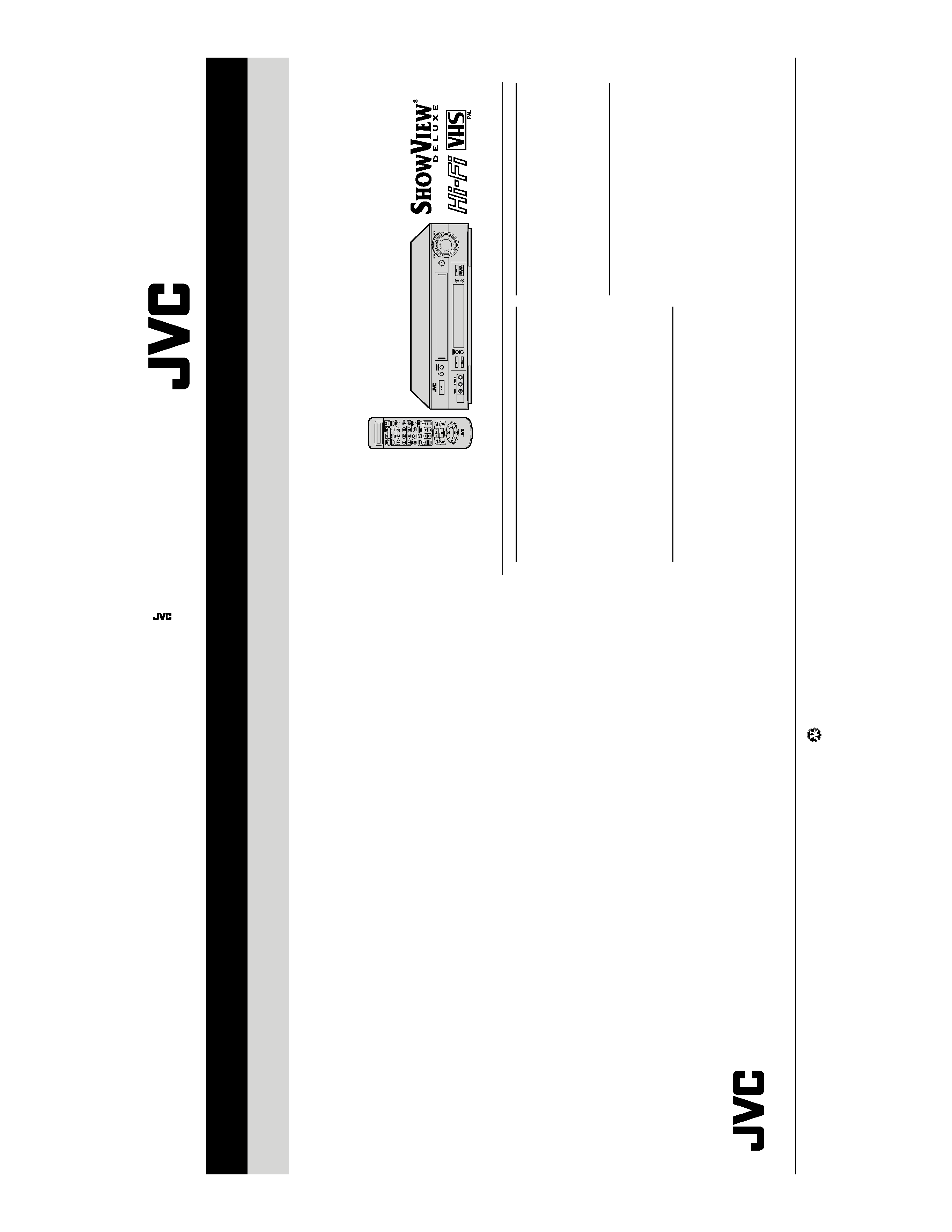
SERVICE MANUAL
No. 82808
August 2000
HR-J870EK/EU
SPECIFICATIONS (The specifications shown pertain specifically to the model HR-J870EU)
VIDEO CASSETTE RECORDER
Printed in Japan
VICTOR COMPANY OF JAPAN, LIMITED
VIDEO DIVISION
S40894
This service manual is printed on 100% recycled paper.
COPYRIGHT © 2000 VICTOR COMPANY OF JAPAN, LTD.
HR-J870EK/EU
No.
82808
GENERAL
Power requirement
: AC 220 V 240 V` , 50 Hz/60 Hz
Power consumption
Power on
: 20 W
Power off
: 5.1 W
Temperature
Operating
: 5°C to 40°C
Storage
: 20°C to 60°C
Operating position
: Horizontal only
Dimensions (WxHxD)
: 400 mm x 94 mm x 346 mm
Weight
: 4.0 kg
Format
: VHS PAL standard
Maximum recording time
(SP)
: 240 min. with E-240 video cassette
(LP)
: 480 min. with E-240 video cassette
(EP)
: 720 min. with E-240 video cassette
VIDEO/AUDIO
Signal system
: PAL-type colour signal and CCIR
monochrome signal, 625 lines 50 fields
Recording system
: DA4 (Double Azimuth) head helical scan system
Signal-to-noise ratio
: 45 dB
Horizontal resolution
(SP/LP)
: 250 lines
(EP)
: 220 lines
Frequency range
: 70 Hz to 10,000 Hz (Normal audio)
20 Hz to 20,000 Hz (Hi-Fi audio)
Input/Output
: 21-pin SCART connectors:
IN/OUT x 1, IN/DECODER x 1
RCA connectors:
VIDEO IN x 1, AUDIO IN x 1, AUDIO OUT x 1
TUNER/TIMER
TV channel storage capacity: 99 positions (+AUX position)
Tuning system
: Frequency synthesized tuner
Channel coverage
: VHF 47 MHz 89 MHz/
104 MHz 300 MHz/
302 MHz 470 MHz
UHF 470 MHz 862 MHz
Aerial output
: UHF channels 22 69 (Adjustable)
Memory backup time
: Approx. 60 min.
ACCESSORIES
Provided accessories
: RF cable,
Satellite Controller RM-SD1,
Infrared remote control unit,
"R6" battery x 2
Specifications shown are for SP mode unless otherwise specified.
E.& O.E. Design and specifications subject to change without notice.
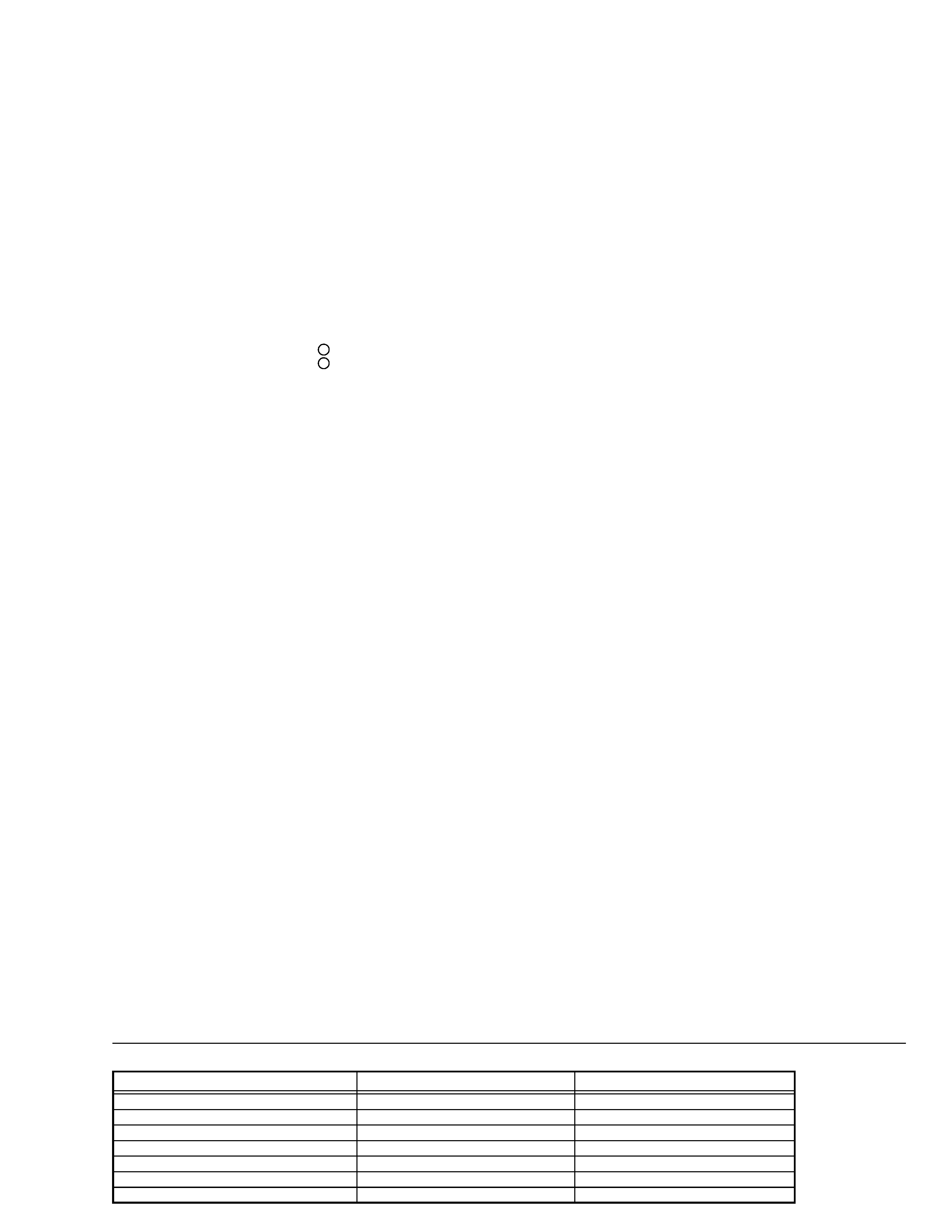
Important Safety Precautions
INSTRUCTIONS
1. DISASSEMBLY
1.1 DISASSEMBLY FLOW CHART ............................................ 1-1
1.2 HOW TO READ THE DISASSEMBLY AND ASSEMBLY ...... 1-1
1.3 DISASSEMBLY/ASSEMBLY METHOD ................................ 1-1
1.4 SERVICE POSITION ............................................................ 1-4
1.4.1 How to take out the Mechanism and Main board assemblies 1-4
1.4.2 Precautions for cassette loading in the "SERVICE POSITION" 1-5
1.4.3 Cassette loading and ejection methods in the
"SERVICE POSITION"(See Fig. 1-4-3). .......................... 1-5
1.5 MECHANISM SERVICE MODE ............................................ 1-5
1.5.1 How to set the "MECHANISM SERVICE MODE" ........... 1-5
1.6 EMERGENCY DISPLAY FUNCTION ................................... 1-6
1.6.1 Displaying the emergency information ............................ 1-6
1.6.2 Clearing the emergency history ....................................... 1-6
1.6.3 Emergency content description ....................................... 1-7
1.6.4 Emergency detail information 1 ....................................... 1-8
1.6.5 Emergency detail information 2 ....................................... 1-9
1.7 SERVICING THE VIDEO NAVIGATION FUNCTION .......... 1-10
1.7.1 Copying the video navigation data ................................ 1-10
1.7.2 Erasing the video navigation data (Initialization) ............ 1-11
1.7.3 Factory setting level during shipment ............................. 1-11
2. MECHANISM ADJUSTMENT
2.1 BEFORE STARTING REPAIR AND ADJUSTMENT ............. 2-1
2.1.1 Precautions ..................................................................... 2-1
2.1.2 Checking for Proper Mechanical Operations ................... 2-1
2.1.3 Manually Removing the Cassette Tape ........................... 2-1
2.1.4 Jigs and Tools Required for Adjustment .......................... 2-2
2.1.5 Maintenance and Inspection ........................................... 2-3
2.2 REPLACEMENT OF MAJOR PARTS ................................... 2-6
2.2.1 Before Starting Disassembling (Phase matching
between mechanical parts) ............................................. 2-6
2.2.2 How to Set the Mechanism Assembling Mode ................ 2-6
2.2.3 Cassette Holder Assembly .............................................. 2-6
2.2.4 Pinch Roller Arm Assembly ............................................. 2-8
2.2.5 Guide Arm Assembly and Press Lever Assembly ........... 2-8
2.2.6 Audio Control Head ......................................................... 2-8
2.2.7 Loading Motor ................................................................. 2-8
2.2.8 Capstan Motor ................................................................. 2-9
2.2.9 Pole Base Assembly (supply or take-up side) ................. 2-9
2.2.10 Rotary Encoder ........................................................... 2-10
2.2.11 Clutch Unit .................................................................. 2-10
2.2.12 Change Lever Assembly, Direct Gear, Clutch Gear and
Coupling Gear ............................................................. 2-10
2.2.13 Link Lever .................................................................... 2-11
2.2.14 Cassette Gear, Control Cam and Worm Gear ............. 2-11
2.2.15 Control Plate ................................................................ 2-11
2.2.16 Loading Arm Gear (supply or take-up side) and
Loading Arm Gear Shaft ............................................. 2-12
2.2.17 Take-up Lever, Take-up Head and Control Plate Guide 2-13
2.2.18 Capstan Brake Assembly ............................................ 2-13
2.2.19 Sub Brake Assembly (take-up side) ............................ 2-13
2.2.20 Main Brake Assembly (take-up side), Reel Disk
(take-up side) and Main Brake Assembly (supply side) ...... 2-13
2.2.21 Tension Brake Assembly, Reel Disk (supply side) and
Tension Arm Assembly ................................................ 2-14
2.2.22 Idler Lever, Idler Arm Assembly .................................. 2-14
2.2.23 Stator Assembly .......................................................... 2-14
2.2.24 Rotor Assembly .......................................................... 2-14
2.2.25 Upper Drum Assembly ................................................ 2-15
2.3 COMPATIBILITY ADJUSTMENT ........................................ 2-16
2.3.1 Checking/Adjustment of FM Waveform Linearity .......... 2-16
2.3.2 Checking/Adjustment of the Height and Tilt of the
Audio Control Head ....................................................... 2-17
2.3.3 Checking/Adjustment of the Audio Control Head Phase
(X-Value) ....................................................................... 2-17
TABLE OF CONTENTS
Section
Title
Page
Section
Title
Page
2.3.4 Checking/Adjustment of the Standard Tracking Preset . 2-18
2.3.5 Checking/Adjustment of the Tension Pole Position ....... 2-18
3. ELECTRICAL ADJUSTMENT
3.1 PRECAUTION ...................................................................... 3-1
3.1.1 Required test equipments ............................................... 3-1
3.1.2 Required adjustment tools ............................................... 3-1
3.1.3 Color (colour) bar signal,Color (colour) bar pattern ......... 3-1
3.1.4 Switch settings and standard precautions ....................... 3-1
3.2 SERVO CIRCUIT .................................................................. 3-2
3.2.1 Switching point ................................................................ 3-2
3.2.2 Slow tracking preset ........................................................ 3-2
3.3 VIDEO CIRCUIT ................................................................... 3-2
3.3.1 AUTO PICTURE initial setting ......................................... 3-2
3.4 SYSCON CIRCUIT ............................................................... 3-2
3.4.1 Timer clock ...................................................................... 3-2
4. CHARTS AND DIAGRAMS
NOTES OF SCHEMATIC DIAGRAM .......................................... 4-1
CIRCUIT BOARD NOTES ........................................................... 4-2
4.1 BOARD INTERCONNECTIONS ........................................... 4-3
4.2 VIDEO/AUDIO AND AUDIO ERASE SCHEMATIC DIAGRAMS . 4-5
4.3 SYSTEM CONTROL SCHEMATIC DIAGRAM ..................... 4-7
4.4 SWITCHING REGUALTOR SCHEMATIC DIAGRAM ........... 4-9
4.5 TUNER SCHEMATIC DIAGRAM ......................................... 4-11
4.6 CONNECTION SCHEMATIC DIAGRAM ............................ 4-13
4.7 TERMINAL SCHEMATIC DIAGRAM .................................. 4-15
4.8 DEMODULATOR SCHEMATIC DIAGRAM ......................... 4-17
4.9 NAVIGATION SCHEMATIC DIAGRAM ............................... 4-19
4.10 NAVIGATION SCHEMATIC DIAGRAM ............................. 4-21
4.11 SW/DISPLAY, REC SAFETY AND JOG SCHEMATIC
DIAGRAMS ....................................................................... 4-23
4.12 CNR SCHEMATIC DIAGRAM ........................................... 4-25
4.13 TERMINAL CIRCUIT BOARD ........................................... 4-27
4.14 DEMODULATOR AND CNR CIRCUIT BOARDS .............. 4-28
4.15 MAIN, A/C HEAD, AUDIO ERASE AND LOADING MOTOR
CIRCUIT BOARDS .............................................................. 4-29
4.16 NAVIGATION CIRCUIT BOARD ....................................... 4-32
4.17 SW/DISPLAY, REC SAFETY AND JOG CIRCUIT BOARDS 4-33
4.18 FDP GRID ASSIGNMENT AND ANODE CONNECTION . 4-35
4.19 REMOTE CONTROL SCHEMATIC DIAGRAM ................. 4-36
4.20 WAVEFORMS ................................................................... 4-37
4.21 VOLTAGE CHARTS .......................................................... 4-38
4.22 CPU PIN FUNCTION ........................................................ 4-39
4.23 SYSTEM CONTROL BLOCK DIAGRAM .......................... 4-41
4.24 VIDEO BLOCK DIAGRAM ................................................ 4-43
4.25 AUDIO BLOCK DIAGRAM ................................................ 4-45
5. PARTS LIST
5.1 PACKING AND ACCESSORY ASSEMBLY <M1> ............... 5-1
5.2 CABINET AND CHASSIS ASSEMBLY <M2> ...................... 5-2
5.3 MECHANISM ASSEMBLY <M4> ......................................... 5-4
5.4 ELECTRICAL PARTS LIST ................................................... 5-6
MAIN BOARD ASSEMBLY <03> ............................................... 5-6
TERMINAL BOARD ASSEMBLY <06> .................................... 5-12
AUDIO CONTROL HEAD BOARD ASSEMBLY <12> ............. 5-13
DEMOD BOARD ASSEMBLY <14> ........................................ 5-13
NAVIGATION BOARD ASSEMBLY <19>
[LPB10108-001*] ..................................................................... 5-14
NAVIGATION BOARD ASSEMBLY <19>
[LPB10108-002*] ..................................................................... 5-14
DISPLAY BOARD ASSEMBLY <28> ....................................... 5-15
REC SAFETY BOARD ASSEMBLY <32> ............................... 5-16
JOG BOARD ASSEMBLY <37> .............................................. 5-16
AUDIO ERASE BOARD ASSEMBLY <46> ............................. 5-16
LOADING MOTOR BOARD ASSEMBLY <55> ....................... 5-16
CNR BOARD ASSEMBLY <89> .............................................. 5-16
HR-J870EK
HR-J870EU
VIDEO SYSTEM
PAL/NTSC PB ON PAL TV
PAL/MESECAM(MANUAL)/NTSCPBONPALTV
TUNER (BROADCASTING STANDARD)
I
B/G, D/K
TUNER (STEREO DECODER)
NICAM
NICAM/A2
TUNER (RF OUT SYSTEM)
I
G, K
DISPLAY (LANG.)
ENGLISH
14 LANGUAGE
TIMER (VCR PLUS+)
VIDEO PLUS+ DELUXE
SHOW VIEW DELUXE
TIMER (VPS)
NOT USED
USED
The following table lists the differing points between Models (HR-J870EK and HR-J870EU) in this series.
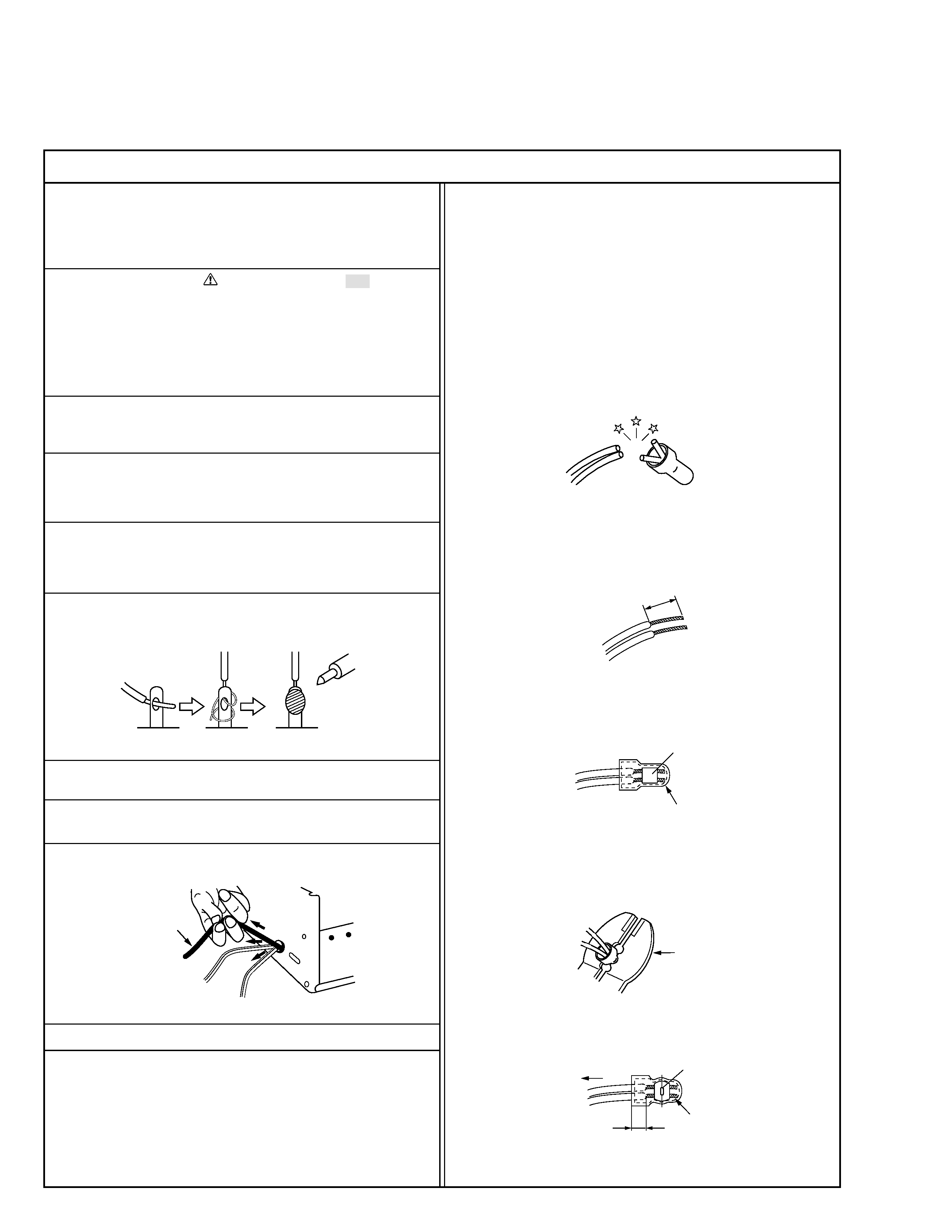
Important Safety Precautions
Prior to shipment from the factory, JVC products are strictly inspected to conform with the recognized product safety and electrical codes of the
countries in which they are to be sold. However, in order to maintain such compliance, it is equally important to implement the following precautions
when a set is being serviced.
Fig.1
1. Locations requiring special caution are denoted by labels and in-
scriptions on the cabinet, chassis and certain parts of the product.
When performing service, be sure to read and comply with these
and other cautionary notices appearing in the operation and serv-
ice manuals.
2. Parts identified by the
symbol and shaded (
) parts are
critical for safety.
Replace only with specified part numbers.
Note: Parts in this category also include those specified to com-
ply with X-ray emission standards for products using
cathode ray tubes and those specified for compliance
with various regulations regarding spurious radiation
emission.
3. Fuse replacement caution notice.
Caution for continued protection against fire hazard.
Replace only with same type and rated fuse(s) as specified.
4. Use specified internal wiring. Note especially:
1) Wires covered with PVC tubing
2) Double insulated wires
3) High voltage leads
5. Use specified insulating materials for hazardous live parts. Note
especially:
1) Insulation Tape
3) Spacers
5) Barrier
2) PVC tubing
4) Insulation sheets for transistors
6. When replacing AC primary side components (transformers, power
cords, noise blocking capacitors, etc.) wrap ends of wires securely
about the terminals before soldering.
Power cord
Fig.2
10. Also check areas surrounding repaired locations.
11. Products using cathode ray tubes (CRTs)
In regard to such products, the cathode ray tubes themselves, the
high voltage circuits, and related circuits are specified for compli-
ance with recognized codes pertaining to X-ray emission.
Consequently, when servicing these products, replace the cath-
ode ray tubes and other parts with only the specified parts. Under
no circumstances attempt to modify these circuits.
Unauthorized modification can increase the high voltage value and
cause X-ray emission from the cathode ray tube.
12. Crimp type wire connector
In such cases as when replacing the power transformer in sets
where the connections between the power cord and power trans-
former primary lead wires are performed using crimp type connec-
tors, if replacing the connectors is unavoidable, in order to prevent
safety hazards, perform carefully and precisely according to the
following steps.
1) Connector part number : E03830-001
2) Required tool : Connector crimping tool of the proper type which
will not damage insulated parts.
3) Replacement procedure
(1) Remove the old connector by cutting the wires at a point
close to the connector.
Important : Do not reuse a connector (discard it).
Fig.7
cut close to connector
Fig.3
(2) Strip about 15 mm of the insulation from the ends of the
wires. If the wires are stranded, twist the strands to avoid
frayed conductors.
15 mm
Fig.4
(3) Align the lengths of the wires to be connected. Insert the
wires fully into the connector.
Connector
Metal sleeve
Fig.5
(4) As shown in Fig.6, use the crimping tool to crimp the metal
sleeve at the center position. Be sure to crimp fully to the
complete closure of the tool.
I
·Precautions during Servicing
7. Observe that wires do not contact heat producing parts (heatsinks,
oxide metal film resistors, fusible resistors, etc.)
8. Check that replaced wires do not contact sharp edged or pointed
parts.
9. When a power cord has been replaced, check that 10-15 kg of
force in any direction will not loosen it.
1.2
5
2.0
5.5
Crimping tool
Fig.6
(5) Check the four points noted in Fig.7.
Not easily pulled free
Crimped at approx. center
of metal sleeve
Conductors extended
Wire insulation recessed
more than 4 mm
S40888-01
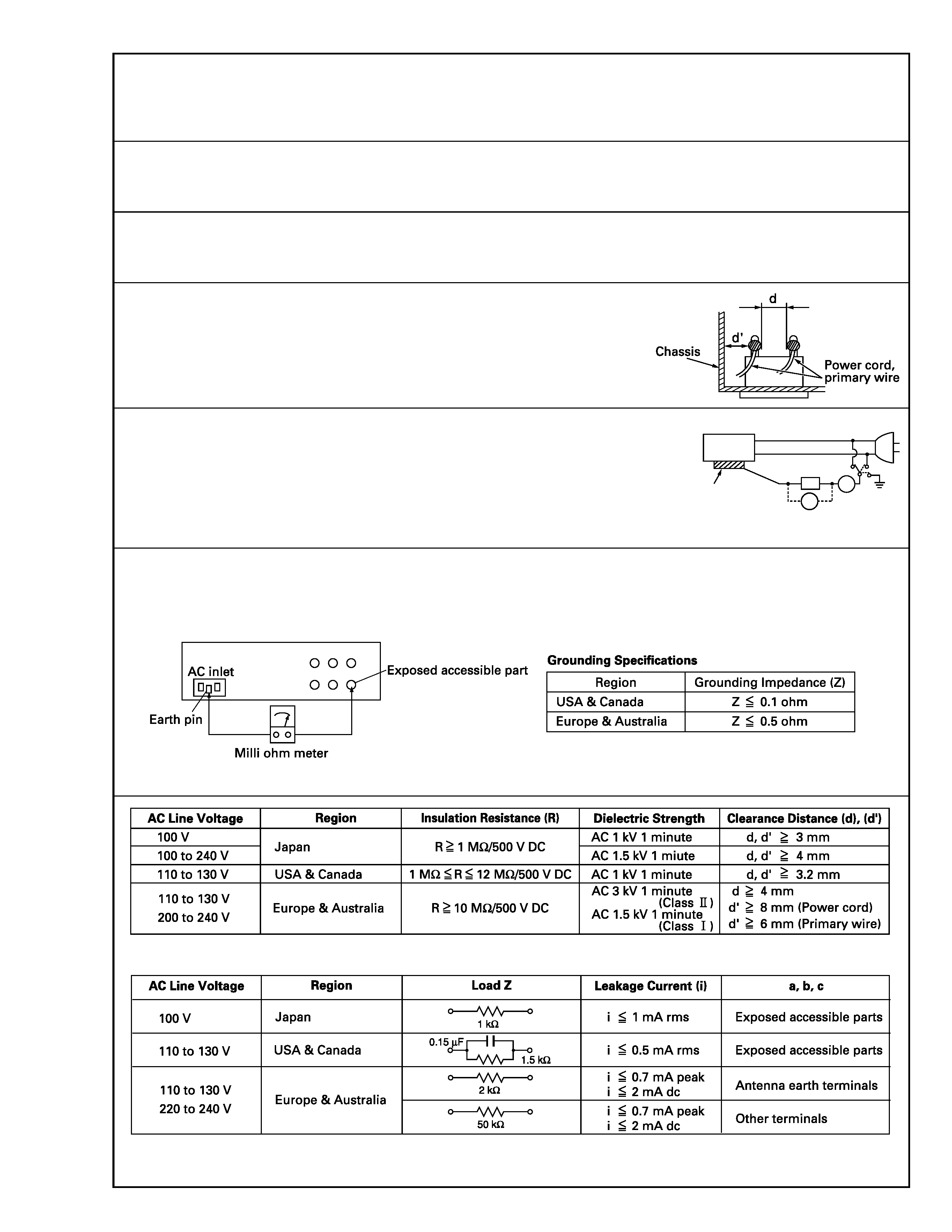
·Safety Check after Servicing
Examine the area surrounding the repaired location for damage or deterioration. Observe that screws, parts and wires have been returned
to original positions, Afterwards, perform the following tests and confirm the specified values in order to verify compliance with safety
standards.
1. Insulation resistance test
Confirm the specified insulation resistance or greater between power cord plug prongs and exter-
nally exposed parts of the set (RF terminals, antenna terminals, video and audio input and output
terminals, microphone jacks, earphone jacks, etc.). See table 1 below.
2. Dielectric strength test
Confirm specified dielectric strength or greater between power cord plug prongs and exposed acces-
sible parts of the set (RF terminals, antenna terminals, video and audio input and output terminals,
microphone jacks, earphone jacks, etc.). See table 1 below.
3. Clearance distance
When replacing primary circuit components, confirm specified clearance distance (d), (d') be-
tween soldered terminals, and between terminals and surrounding metallic parts. See table 1
below.
4. Leakage current test
Confirm specified or lower leakage current between earth ground/power cord plug prongs and
externally exposed accessible parts (RF terminals, antenna terminals, video and audio input and
output terminals, microphone jacks, earphone jacks, etc.).
Measuring Method : (Power ON)
Insert load Z between earth ground/power cord plug prongs and externally exposed accessible
parts. Use an AC voltmeter to measure across both terminals of load Z. See figure 9 and following
table 2.
5. Grounding (Class 1 model only)
Confirm specified or lower grounding impedance between earth pin in AC inlet and externally exposed accessible parts (Video in, Video out,
Audio in, Audio out or Fixing screw etc.).
Measuring Method:
Connect milli ohm meter between earth pin in AC inlet and exposed accessible parts. See figure 10 and grounding specifications.
Fig. 10
Fig. 9
Fig. 8
Table 1 Specifications for each region
Table 2 Leakage current specifications for each region
Note: These tables are unofficial and for reference only. Be sure to confirm the precise values for your particular country and locality.
II
S40888-01
ab
c
V
A
Externally
exposed
accessible part
Z
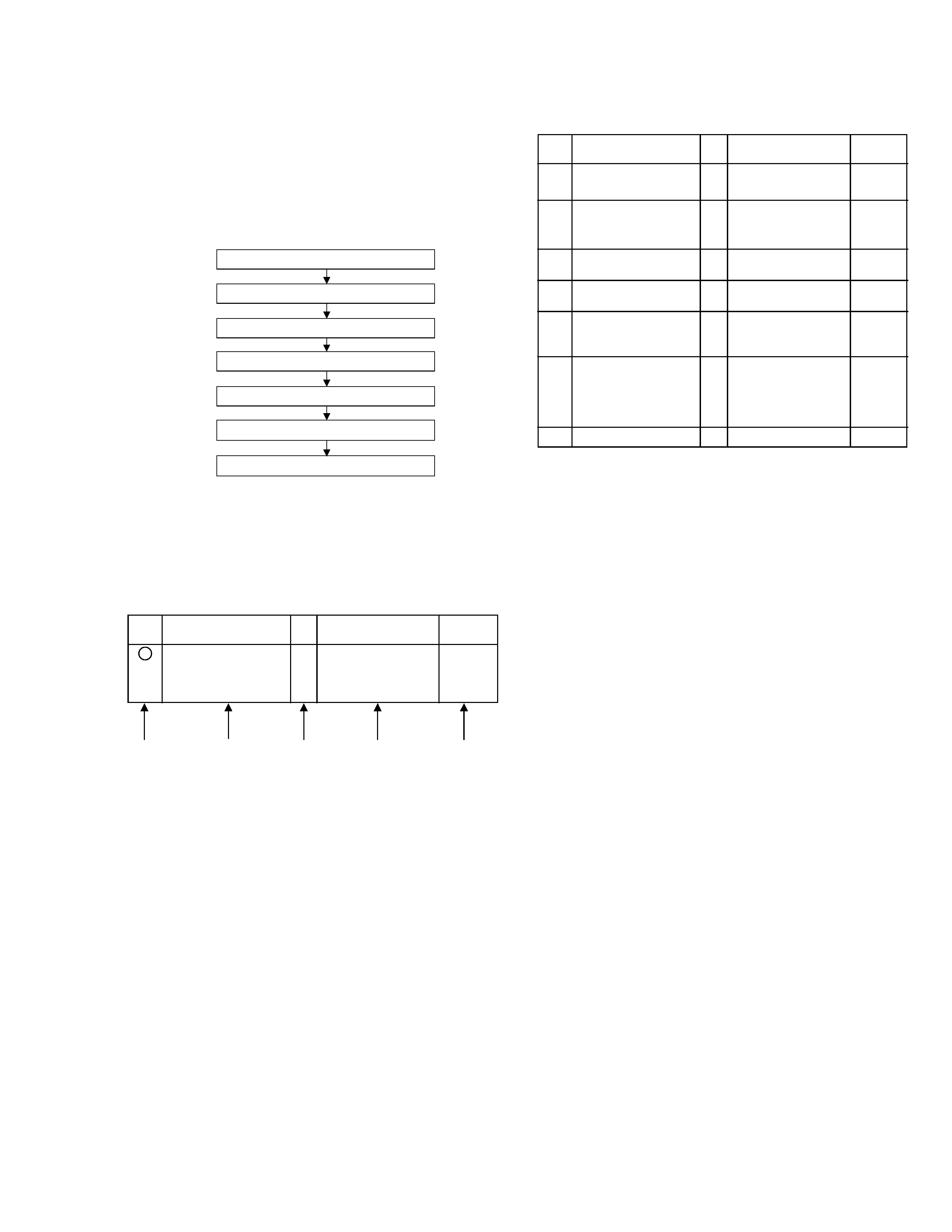
1-1
SECTION 1
DISASSEMBLY
1.3 DISASSEMBLY/ASSEMBLY METHOD
1.1 DISASSEMBLY FLOW CHART
This flowchart lists the disassembling steps for the cabinet
parts and P.C. boards in order to gain access to item(s) to
be serviced. When reassembling, perform the step(s) in re-
verse order. Bend, route and dress the flat cables as they
were originally laid.
Step/
LocNo.
Part Name
Fig.
No.
Point
Note
1.2 HOW TO READ THE DISASSEMBLY AND ASSEMBLY
Note:
· The bracketed ( ) WR of the connector symbol are as-
signed nos. in priority order and do not correspond to
those on the spare parts list.
(5) Adjustment information for installation
<Note 2>
· When attaching the Bottom cover, make sure that the Earth
plate of the Bottom cover is passed through the hole of the
Bottom chassis and then touches the GND (Ground) on the
Main board assembly.
<Note 3a>
· Be careful not to damage the connector and wire etc. during
connection and disconnection.
When connecting the wire to the connector, be careful with
the wire direction.
<Note 3b>
· When reattaching the Front panel assembly, make sure that
the door opener a of the Cassette holder assembly is low-
ered in position prior to the reinstallation.
<Note 5a>
· When it is required to remove the screws (S5a) retaining
the Mechanism assembly, please refer to the "Procedures
for Lowering the Cassette holder assembly"(See on pages
1-2).
· When removing the Mechanism assembly only, unhook the
two spacers connecting it with the Main board assembly
with pliers from the back side of the Main board assembly
first, and then remove the Mechanism assembly.
· When reattaching the Mechanism assembly to the Main
board assembly, take care not to damage the sensors on
the Main board assembly (D3001: LED, Q3002: Start sen-
sor, Q3003: End sensor, S3002 : S cassette switch).
<Note 5b>
· The wire (WR5) has excess length that may be loose, as it
is quite long. After inserting the wire and connectors, the
loose portion of the wire should be taken up and accommo-
dated between the A/C head base and the main deck.
<Note 6>
· The REC safety board assembly is attached to the SW/Dis-
play board assembly. It is therefore necessary to remove
the REC safety board assembly before removing the SW/
Display board assembly.
Top cover, Bracket
Bottom cover
Front panel assembly
Drum assembly
Mechanism assembly
SW/Display board assembly
Main board assembly
1
2
3
4
5
6
7
----------------- -
1
Top cover,
D1 4(S1a), (S1b)
Bracket
2(S1c)
2
Bottom cover
D2 (S2a),
<Note 2>
2(S2b),4(L2a),3(L2b)
Earth plate
3
Front panel assembly
D3 7(L3),CN3012(WR3) <Note 3a>
<Note 3b>
4
Drum assembly
D4 3(S4),CON1(WR4a), <Note 3a>
CN1(WR4b)
5
Mechanism assembly D5 2(S5a),(S5b),(S5c), <Note 3a>
2(L5), CN1(WR5)
<Note 5a>
<Note 5b>
6
SW/Display board
D6 CN7001(WR6a),
<Note 3a>
assembly
CN7191(WR6b),
<Note 6>
(L6a),
REC safety board assy,
2(L6b), 5(L6c)
7
Main board assembly
D7 2(S7), (L7)
----------------- -
(1)
(2)
(3)
(4)
(5)
Step/
LocNo.
Part Name
Fig.
No.
Point
Note
1
Top cover,
D1 4(S1a),(S1b),3(L1a),
<Note 1>
2(SD1a),(P1a),
CN1(WR1a),
Bracket
2(S1c)
<Example>
(1) Order of steps in Procedure
When reassembling, perform the step(s) in the reverse order.
These numbers are also used as the identification (location) No.
of parts Figures.
(2) Part name to be removed or installed.
(3) Fig. No. showing procedure or part location.
(4) Identification of part to be removed, unhooked, unlocked,
released, unplugged, unclamped or unsoldered.
P= Spring, W= Washer, S= Screw, L= Locking tab, SD= Solder,
CN**(WR**)= Remove the wire (WR**) from the connector
(CN**).
